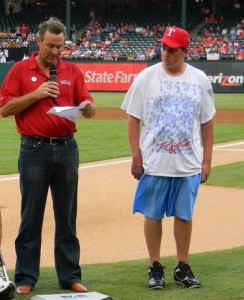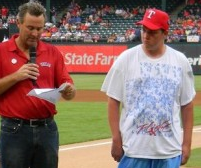For one St. Thomas senior, college graduation holds more appeal than a diploma, cap and gown.

As a 17-year-old high school junior, Alex Grausnick was diagnosed with a disease that had the potential to steal his ability to play the sports he loves, confine him to a wheelchair and give him a life expectancy of two to five years.
Grausnick has had more than homework and his GPA to worry about in his four years at St. Thomas; he’s had to deal with a diagnosis of the progressive neurodegenerative disease Amyotrophic Lateral Sclerosis (ALS).
“At first I thought, ‘maybe I won’t make it through college,’” Grausnick said.
Grausnick has spent the past five years defying many limitations of the disease. He worked on his finance and Spanish double major, played three years of varsity golf and raised awareness about ALS. And he’s done it all without any serious progression of the disease.
ALS, commonly known has Lou Gehrig’s disease, got its colloquial name after baseball player Lou Gehrig was diagnosed in 1939. Gehrig’s subsequent battle was the inspiration that led Major League Baseball to become the platform for the Young Faces of ALS campaign that included Grausnick as an ambassador.
Grausnick spent part of the 2010 summer attending Major League Baseball games with nine other ALS patients, all under 30 years old, to raise awareness about the disease.
He would arrive early to the games to watch batting practice and then participate in a pregame ceremony on the field.
Grausnick’s face was broadcast on stadium JumboTrons while he stood on the field.
“They have the camera pretty close to your face. So you’re standing there in front of 50,000 people… you don’t know if you’re supposed to smile and stare into the camera,” he said.
Grausnick said he hopes that attending the baseball games has helped bring actual faces of the disease to the public and plans to continue to play a role in advocacy for ALS awareness and research.
Dealing with the diagnosis
Grausnick said that his mom was the first one to notice something was wrong.
“My mom noticed that if I went to grab a glass of water or a glass of milk, I would just kind of grab it with my forefingers; and my thumb would just be off to the side,” he said.
Grausnick and his family then went through what he described as “the chain of command for doctors,” starting with his primary care doctor and a hand specialist, and ending with neurologists at the University of Minnesota.
“It was kind of a long process… I don’t think it took a year, but it took a good chunk of months to get all that done and figured out,” he said.
While in and out of doctor’s visits, Grausnick said he was never really worried.
“I think I thought it would be something small, something so minor that it wouldn’t even matter. Looking back now, I probably should have been more worried or more preoccupied than I was, but I think its just part of being a kid, that you don’t really think about that stuff,” Grausnick said.
Grausnick was diagnosed with ALS the May before his senior year of high school, and both of his parents “broke down.”
“I didn’t really know what it was so I was just in shock, but I could tell it was something bad just because of how my parents reacted,” Grausnick said.
One of the biggest changes Grausnick has seen in himself since his diagnosis has been an overall change in his attitude and a desire to take each day as it comes.
“It kind of makes you realize your life could be short just as easily as you could live to be 90,” he said.
Friend and former golf teammate John Baggenstoss said he agrees that Grausnick maintains a positive attitude despite his diagnosis.
“He’s one of the funniest people I’ve ever met. I’ve never once heard him complain about having (ALS)… I think he’s got a great attitude,” said Baggenstoss, a senior.
Baggenstoss remembers his first experience with Grausnick, when Grausnick arrived at St. Thomas golf tryouts in a “tricked out” gold mini van, blasting rap music.
“That day he beat me by four or five (strokes)… he had this career day, and I thought, ‘Who does this kid think he is?’”
Grausnick said he can’t explain why the disease seems to be only affecting his hand after almost five years.
“My doctor doesn’t know how to explain it either. The only thing he can think of is that in some rare cases, the progression stops or plateaus. That’s the only thing that makes sense.
“Otherwise it just doesn’t. None of it really makes any sense,” Grausnick said.
Grausnick, along with many of those around him, said he hopes that the lack of progression could be a result of his positive attitude.
“If your mind thinks something, it will kind of come about that way,” he said.
Mary Daugherty, one of Grausnick’s St. Thomas finance professors, said that she has high hopes for what the future holds for Grausnick.
“Who knows? God works in mysterious ways, he may hold this disease off for decades and live a long life,” Daugherty said. “On the other hand… there’s also opportunities for researchers to come up with solutions.”
For the past five years, Grausnick has been living the life of any other St. Thomas student and experiencing things he thought he might not even get the chance to do.
“I remember at one point, thinking about all of the things I wouldn’t get to do like go through college, get married, have kids, raise a family… I think as all those moments come and go, I’ll look back and think how blessed I was to be able to do all of this and how lucky I am to still be here.”
Heidi Enninga enni5264@stthomas.edu.




This young man may be a role model that other college students could learn a great deal from.
Great article- very inspiring. TM could use more articles like this one.